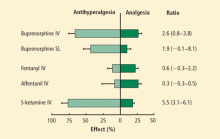The emerging role of palliative medicine in the treatment of lung cancer patients
ABSTRACTThe symptom burden of patients with lung cancer is extensive and includes loss of appetite, dyspnea, and other symptoms that lead to decreased quality of life. Randomized controlled trial data indicate that early palliative care improves quality of life and depressive symptoms and may extend survival in advanced non–small cell lung cancer compared with standard care. Combining an appetite stimulant (megestrol acetate) with an atypical antipsychotic (olanzapine) leads to greater weight gain and appetite improvement compared with an appetite stimulant alone. Cancer-related dyspnea appears to be a “central” effect that stems from altered afferent inputs in the setting of ventilatory muscle weakness; various treatment options that have shown success in treating cancer-related dyspnea are opioids, tunneled pleural catheters, bilevel positive airway pressure, and nebulized furosemide. Buprenorphine is a unique opioid with activity at mu and nociceptin receptors (also called opioid-receptor-like receptors); it improves pain states dominated by central sensitization.
BUPRENORPHINE: UNIQUE OPIOID
Buprenorphine is a mu- and nociceptin (ORL-1)-receptor partial agonist with intravenous, subcutaneous, sublingual, transdermal, and intranasal routes of delivery.23 An agent that acts as an ORL-1 agonist can induce analgesia by blocking nociceptive responses at the level of the spinal cord. It is a kappa antagonist (depending upon the kappa ligand used in the assay), which may contribute to its antihyperalgesia. The parent drug has a high affinity and low intrinsic efficacy for the mu receptor. The main metabolite, norbuprenorphine, is a delta opioid-receptor agonist.
Secondary hyperalgesia is an increased sensitivity to painful stimuli around an area of injury and occurs frequently following injury. The increased pain sensation is a result of central sensitization derived from brainstem neurons that facilitate pain; it is not derived from afferent signals from the primary site. Secondary hyperalgesia is less responsive to opioids than primary hyperalgesia at the site of injury.
Pain is improved with buprenorphine predominantly through modulation of central sensitization and less so at the primary site. Koppert et al25 demonstrated in human volunteers that buprenorphine reduced the area and duration of secondary hyperalgesia more than pain at the site of injury (half-life of 171 minutes vs 288 minutes, respectively). Buprenorphine had a much greater antihyperalgesic effect than analgesic effect compared with potent opioids such as fentanyl. In contrast, the analgesic effects with fentanyl and alfentanil were much greater than their antihyperalgesic effects (Figure), suggesting the possibility of a combination of opioid therapy for superior pain relief or choices based on pain phenotype (eg, secondary or primary hyperalgesia).
SUMMARY
Early palliative care improves quality of life and decision-making in patients with advanced lung cancer and may improve survival, although survival data need to be confirmed. Olanzapine and megestrol acetate are superior to megestrol acetate alone for the treatment of anorexia. Oxygen is no better than medical air in the management of dyspnea associated with normal oxygen saturation. Buprenorphine is a unique opioid that has value for pharmacologic relief in patients at risk for respiratory depression.








